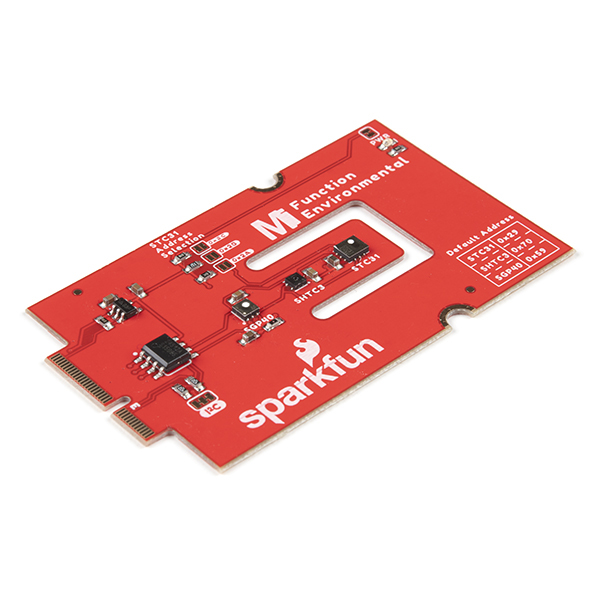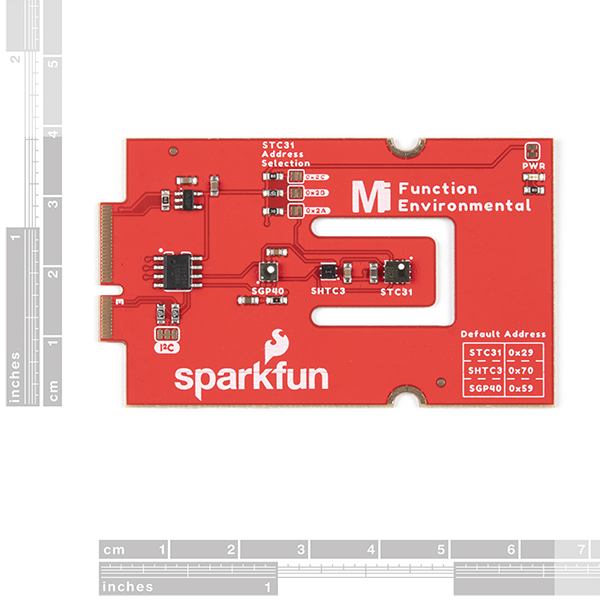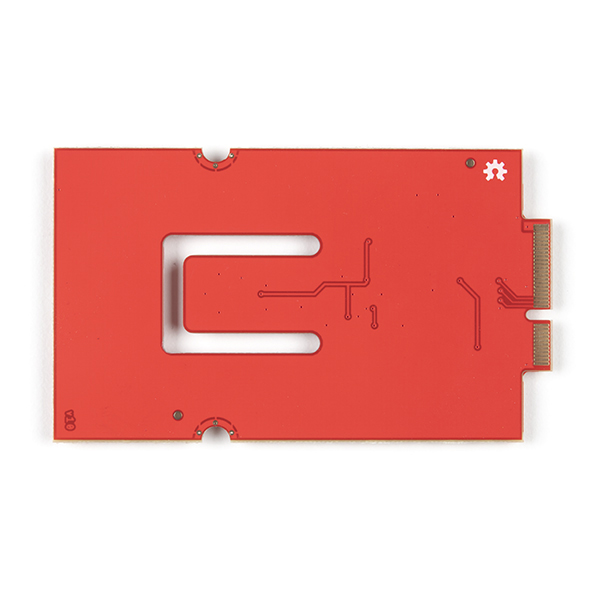SparkFun MicroMod Environmental Function Board
The SparkFun MicroMod Environmental Function Board adds additional sensing options to the MicroMod Processor Boards. This Function Board includes three sensors to monitor air quality (SGP40), humidity & temperature (SHTC3), and CO2 concentrations (STC31) in your indoor environment. To make it even easier to use, all communication is over the MicroMod's I2C bus!
The SGP40 measures the quality of the air in your room or house. The SGP40 uses a metal oxide (MOx) sensor with a temperature controlled micro hotplate and provides a humidity-compensated volatile organic compound (VOC) based indoor air quality signal. Both the sensing element and VOC Algorithm feature an unmatched robustness against contaminating gases present in real world applications enabling a unique long term stability as well as low drift and device to device variation.
The SHTC3 is a highly accurate digital humidity and temperature sensor. The SHTC3 uses a capacitive humidity sensor with a relative humidity measurement range of 0 to 100% RH and bandgap temperature sensor with a temperature measurement range of -40°C to 125°C. The SHTC3 builds on the success of their SHTC1 sensor with higher accuracy (±2% RH, ±0.2°C) than its predecessor, enabling greater flexibility.
The STC31 measures CO2 concentrations based on thermal conductivity and has two CO2 measurement ranges: 0 to 25 vol%; and 0 to 100 vol%. The measurement repeatability is 0.2 vol%, with a stability of 0.025 vol% / °C. The measurement accuracy depends on the measurement range: 0.5 vol% + 3% measured value; 1 vol% + 3% measured value. Using measurements from the SHTC3, the STC31 is able to provide humidity-compensated measurements together with improved temperature compensation. The STC31 can compensate for atmospheric pressure too - which is handy if, like us, you’re up in the mountains!
The outstanding performance of these three sensors is based on Sensirion’s patented CMOSens® technology, which combines the sensor element, signal processing, and digital calibration on a small CMOS chip. The well-proven CMOS technology is perfectly suited for high-quality mass production and is the ideal choice for demanding and cost-sensitive OEM applications.
Utilizing our handy M.2 MicroMod connector, no soldering is required to connect it to your system. Simply match up the key on your processor and function board's beveled edge connector to their respective key on the M.2 connector, then secure them to the main board with screws. The MicroMod Environmental Function Board can then be read via the I2C port. The board is equipped with the AP2112 3.3V voltage regulator, I2C pull-up resistors, power LED, jumper to disable the LED, and jumpers for alternative STC31 addresses.
Note: A MicroMod Processor and Main Board are not included with this MicroMod Environmental Function Board. These boards will need to be purchased separately.
MicroMod is a modular interface ecosystem that connects a microcontroller “processor board” to various “carrier board” peripherals. Utilizing the M.2 standard, the MicroMod standard is designed to easily swap out processors and function boards on the fly. Pair a specialized carrier board for the project you need with your choice of compatible processor!
- Input voltage range
- 2.5V to 6.0V
- Typ. 5V via Main Board's USB connector
- Typ. ~3.7V to 4.2V via Main Board's LiPo battery Connector
- 2.5V to 6.0V
- I/O voltage
- 3.3V
- AP2112 3.3V voltage regulator (rated 600mA)
- Power LED
- I2C pull-up resistors
- Sensirion SGP40 Air Quality Sensor
- Uses I2C interface
- Address: 0x59 (default)
- Operating voltage range
- 1.7V to 3.6V (Typ. 3.3V)
- Operating temperature range
- -20°C to +55°C
- Typical current consumption
- 2.6mA during continuous operation (at 3.3V)
- 34µA when idle (heater off)
- Output signal
- Digital raw value (SRAW): 0 - 65535 ticks
- Digital processed value (VOC Index): 0 - 500 VOC index points
- Switch-on behavior
- Time until reliably detecting VOC events: <60s
- Time until specifications are met: <1h
- Recommended sampling interval
- VOC Index: 1s
- SRAW: 0.5s - 10s (Typ. 1s)
- Uses I2C interface
- Sensirion SHTC3 Humidity and Temperature Sensor
- Uses I2C interface
- Address: 0x70 (default, non-configurable)
- Operating voltage range
- 1.62V - 3.6V (Typ. 3.3V)
- Operating temperature range
- -40°C to +125 °C
- Relative Humidity
- Measurement range: 0% to 100%
- Typical accuracy: ±2 %RH
- Resolution: 0.01 %RH
- Temperature
- Measurement range: -40°C to +125 °C
- Typical accuracy: ±0.2 °C
- Resolution: 0.01 °C
- Typical current consumption (varies based on mode)
- 4.9µA to 430µA (Normal Mode)
- 0.5µA to 270µA (Low Power Mode)
- Allows the STC31 to compensate for humidity and temperature
- Uses I2C interface
- Sensirion STC31 CO2 Sensor
- Uses I2C interface
- Addresses: 0x29 (default), 0x2A, 0x2B, 0x2C
- Operating voltage range
- 2.7V to 5.5V (Typ. 3.3V)
- Operating temperature range
- -20 °C to +85 °C
- Calibrated for CO2 in N2 and CO2 in air
- Measurement ranges
- 0 to 25 vol% in N2
- 0 to 100 vol% in air
- Accuracy
- 0.5 vol% + 3% measured value in N2
- 1 vol% + 3% measured value in air
- Concentration and temperature resolution: 16-bit
- Repeatability: 0.2 vol%
- Temperature stability: 0.025 vol% / °C
- Start-up time: 14 ms
- Thermal conductivity sensor provides calibrated gas concentration and temperature output
- Uses I2C interface
- Jumpers
- PWR LED
- I2C pull-up resistors
- STC31 address selection
Note: The I2C addresses that are reserved for each sensor is 0x59 (SGP40), 0x70 (SHTC3), 0x29 (STC31). A multiplexer/Mux is required to communicate to multiple SHTC3 sensors on a single bus. The SHTC3 uses the same address as the Qwiic Mux (0x70). For advanced users that are using multiple SHTC3's with the Qwiic Mux, you will need to adjust the Qwiic Mux's default address.
Hardware Documentation:
- Schematic
- Eagle Files
- Board Dimensions
- Hookup Guide
- SGP40
- SHTC3
- STC3X
- Arduino Libraries
- GitHub Hardware Repo
MicroMod Documentation:
SparkFun MicroMod Environmental Function Board Product Help and Resources
MicroMod Environmental Function Board Hookup Guide
November 11, 2021
The SparkFun MicroMod Environmental Function Board adds additional sensing options to the MicroMod Processor Boards. This function board includes three sensors to monitor air quality (SGP40), humidity & temperature (SHTC3), and CO2 concentrations (STC31) in your indoor environment. To make it even easier to use, all communication is over the MicroMod's I2C bus! In this tutorial, we will go over how to connect the board and read the sensors.
Designing with MicroMod
October 21, 2020
This tutorial will walk you through the specs of the MicroMod processor and carrier board as well as the basics of incorporating the MicroMod form factor into your own PCB designs!
Getting Started with MicroMod
October 21, 2020
Dive into the world of MicroMod - a compact interface to connect a microcontroller to various peripherals via the M.2 Connector!
Core Skill: Programming
If a board needs code or communicates somehow, you're going to need to know how to program or interface with it. The programming skill is all about communication and code.
Skill Level: Competent - The toolchain for programming is a bit more complex and will examples may not be explicitly provided for you. You will be required to have a fundamental knowledge of programming and be required to provide your own code. You may need to modify existing libraries or code to work with your specific hardware. Sensor and hardware interfaces will be SPI or I2C.
See all skill levels
Core Skill: Electrical Prototyping
If it requires power, you need to know how much, what all the pins do, and how to hook it up. You may need to reference datasheets, schematics, and know the ins and outs of electronics.
Skill Level: Rookie - You may be required to know a bit more about the component, such as orientation, or how to hook it up, in addition to power requirements. You will need to understand polarized components.
See all skill levels
Comments
Looking for answers to technical questions?
We welcome your comments and suggestions below. However, if you are looking for solutions to technical questions please see our Technical Assistance page.
Customer Reviews
5 out of 5
Based on 1 ratings:





